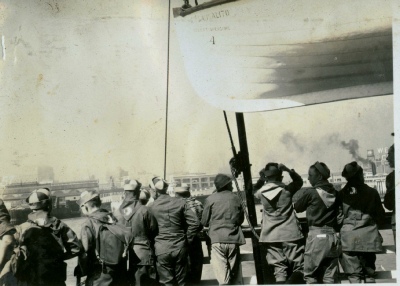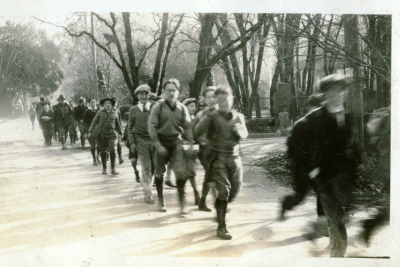






















After the close of the original Camp Lilienthal weekend camp in San Francisco’s Stern Grove area in 1925 due to lack of funds, the San Francisco Council was still in need of a permanent all weather camp that was local to the San Francisco area. Its new summer training camp in Cazadero (Camp Royaneh), acquired in 1925, was too far away for weekend use during the early years and was not suitable during the rainy winter months. In 1927 the San Francisco Council began looking for a year-round camping site closer to home in which to sponsor weekend camping trips and scout training.
In a 1927 letter addressed to the parents of scouts belonging to the San Francisco Council, President Charles C. Moore stated the aims of a capital fund drive initiated by the Council. “We are about to launch out upon a campaign for funds with which to establish our new weekend camp and to purchase Camp Royaneh, our summer Training Camp near Cazadero. Four years ago we conducted the weekend camp at Sloat Boulevard and 26th Avenue where our Scouts were able to take advantage of real opportunity to pass their tests in the out-of-doors during almost any time of year. The property was later set aside for subdivision, and consequently we have not been able to offer the membership the same advantages enjoyed by the scouts who were in the movement some years ago. We have now received clearance from the Community Chest and the San Francisco Endorsement Council for this campaign, and as a result we plan to make available to our boys the finest weekend camp in America, to be known once again as the Jesse Lilienthal Camp. In addition we have a wonderful campsite for our summer activities near Cazadero, upon which we made a small payment down and we are eager to secure this property under the ownership of the San Francisco District Council.” The capital fund raising campaign was set at $42,500 and was led by Max Lilienthal a member of the Council Board and nephew of the late Jesse Lilienthal. He was a partner in the firm of Lilienthal, Bremer and Company and a member of the San Francisco Stock and Bond Exchange.
The need for a permanent weekend camp though would drag on for two more years as the site selection committee looked at properties across the bay and down the peninsula. In early 1929 the Fairfax estate of William Kent in Marin County was offered to the San Francisco Council. The 20 acre property was located above the town of Fairfax on Bolinas road and was originally part of the 120 acre William Jory ranch. The property consisted of a large two story log cabin built by William Jory in 1896, a small orchard and a stand of redwoods. No other structures were located on the estate. The property was surrounded by open land and had direct access to the nearby Lakes of Alpine and Lagunitas and many hiking trails of Mt Tamalpais. William Kent, who died in 1928, was a well-known philanthropist as well as a United States Congressman. In 1908 it was William Kent who donated 295 acres of his real estate holdings at the urging of John Muir to the Federal Government to create the Muir Woods National Monument. Those 295 acres on the southern slopes of Mt Tamalpais in an area known as Redwood Canyon contained a 1300 year old virgin redwood forest. The town of Kentfield located about five miles east of his estate is named after his family.
In April of 1929, John McGregor and Max Lilienthal acting as trustees for the San Francisco Boy Scouts purchased the Kent Estate for $22,000 for use as their new weekend camp. The Council would once again name the camp “Lilienthal” in honor of the late Jesse Lilienthal (first council President). Dedication of the all year Camp Lilienthal occurred on May 18, 1929. According to the "San Francisco Scout" newsletter of June 1929, "everyone was delighted with the beautiful campsite. The tents looked inviting and all the Scouts were eager to get started on the weekend trips to the camp”. The temporary headquarters for the camp was the large two story log house (the former Jory home). Ralph Bennet, former Scoutmaster of Troop 44, was the first Camp Director and had his office and living quarters in the log house. As the crowds of parents, friends and Scouts approached the camp they were taken by guides to point out the places of interest which were yet to be developed such as the Lilienthal Administration Building, the Frederick Morley Memorial Hospital (named after Fred William Morley, a camper that died in a mountaineering accident at Yosemite), The Mary Miramontes Hunan Camp Vocational Building and Museum, the swimming pool, amphitheater and troop campsites. However, the Miramontes vocational building would be renamed the Charles C. Moore Vocational building after it was constructed.
It was explained that the general troop cabins would be constructed by service clubs and other organizations and that some of the troops will erect their own hillside cabins on sites to be determined later. The dedication ceremonies were held in the beautiful amphitheater in the afternoon following a concert by the San Francisco Boy Scout Band. Mr. Lilienthal, Chairman of the committee on weekend camps presided over the ceremonies. Also present at the ceremony was Mrs. Jesse Lilienthal, Jesse Lilienthal Jr. and other members of the Lilienthal family.
Saturday, June 1, 1929, was the first day that the camp was formally opened for reservations. The camp was overflowing with scouts with the following troops in attendance: Troops 15, 69, 85, 95, 100, and 234. That evening a campfire was held at the amphitheater and all the scouts were reported as having a great time.
In the March 1930 issue of the "San Francisco Scout" a progress report was given on the construction of the new buildings taking place at Camp Lilienthal. The Administration building is nearing completion and the Vocational Building is well underway. Excavations for the Hospital Building had begun and the swimming pool and troop cabins were expected to be completed by the fall. The Fairfax Gazette in its June 11, 1930, issue carried the notice on its front page of the dedication of the new buildings at the camp, "The executive board of the San Francisco Area Council of the Boy Scouts of America presided at the dedication of new buildings at Camp Lilienthal near Fairfax Sunday afternoon. The structures dedicated were the Lilienthal Administration building, the Frederick H. Morley Memorial Hospital and the Charles C. Moore Hall." The Lilienthal Administrative Building contained the main house, a kitchen, a rifle range and a vegetable house out back. The rifle range for the camp was actually located in the basement of the main house directly beneath the mess hall. The San Francisco Scout newsletter of December 1930 reported the completion of the swimming pool to which was added a large chlorinating plant and a fence constructed completely around it. The pool was dedicated to John McGregor and was henceforth known to generations of scouts as the McGregor Swimming Pool. One of the earliest camp directors at Lilienthal was Leland Dickieson. The scout bulletins used the title "Camp Superintendent" for Mr. Dickieson as he was responsible for the overall facilities and was the superintendent from the early 1930's until the early 1940's.
Transportation to camp in the early years meant the scouts would catch a ferry boat from San Francisco and disembark in Sausalito. From Sausalito they would then hop a train over to the town of Fairfax where they dropped off their camping equipment at the Fairfax Park near the train station. A truck from camp would drive down later and pick up the gear while the Scouts would hike the 2 miles from the park up to the camp entrance at Bolinas Road near where it intersected with Sky Oaks Road. The main entrance to the camp was located on a blind curve of Bolinas Road and did not provide very good visibility. Years later when the camp was sold, the town of Fairfax required that the road into the property get moved further up the road. However while it was a scout camp, the road into camp went past the archery range, the rangers log cabin and ended in front of the Admin building.
Improvements made to the camp in 1931 included a brick area for lockers on the east side of the log cabin and installation of ten food lockers on the brick area. Stairs were built up the main runway of tents. The log cabin was rewired. All barbed wire was removed from the premises, some 3500 feet of it that was left over from the days when the property had been used for ranching. Suckers were cut from the redwood groves and dead stumps removed from the orchard. The orchard had been planted originally by William Jory before the turn of the century. The orchard fruit trees remaining were all trimmed. Rustic cabinets were built around the electrical service boxes in the redwood groves to conceal them. A culvert was installed in the ditch along the road up to the filter plant and repairs were made on the road up to the "haunted house".
Also during the 1931 camping season Troops 85 and 104, under the guidance of their scoutmasters, constructed one of the largest troop cabins on the property. It was built on the hill above the hospital building and overlooked the camp. The structure was capable of housing forty-eight boys at a time. Other cabins constructed that year were those of Troops 2, 37 and 88. When ground was broken for Troop 88's cabin, some sixty-five parents, along with a number of scout leaders, celebrated the event. The same occasion was also used to dedicate a flagpole which was erected in front of Troop 2's cabin. Troop 234, which had the American Legion as its sponsor, also completed a cabin that year. Other troops that also maintained cabins were Troops 69, 85, 93 and 95.
The annual Mothers' Day gathering at Camp Lilienthal for all Scouts, Scouters, and their families was started in the early 1930’s. At these gathering there were picnics, races and the opportunity to swim in the large pool. As each family entered the camp they were greeted by the Camp Director who was standing on a wooden stage that was located near the entrance to the camp. Joe Ehrman III (future Silver Beaver and Distinguished Eagle Scout Recipient) visited Camp Lilienthal on one of those early gatherings before he was a Scout, as his family was the guest of Hilda and Max Lilienthal. On one of those occasions, Joe was introduced to Raymond Hanson, the beloved San Francisco Scout Executive. Hanson offered Joe the Boy Scout Handshake, but little Joe objected, saying he was not a Boy Scout. Hanson replied to Joe "But you will be!” Never-the-less Joe still got a handshake from Mr. Hanson.
From a 1934 camping bulletin, the cost per day for scouts staying at Camp Lilienthal was $1.00 or $7.00 per week depending on the meal plan. Scouts were charged 40 cents for single meals. Campers were expected to wear the scout uniform. Neckerchiefs and caps were optional but could be secured at the camp at a cost of $1.20 for both items. Transportation was by ferry and train to Fairfax at a cost of 60 cents for the round trip ticket. Baggage would be transported from the train station at Fairfax to the camp but scouts were expected to walk the distance from the station to the camp. Scouts could arrange to cook their own meals provided reservations were made in advance and space to do so was available. Otherwise scouts ate their meals in the dining hall. All scouts camping on the ground during the summer months were required to participate in regular camp programs. Scouts registering as individuals were assigned to a troop. Among the many skills which could be learned at camp were the proper use and handling of an axe, learned at the "Peter McLaren Axe yard", the use of bows and arrows at the archery range and the proper use and handling of rifles at the camp's rifle range. The rifle range was located in the basement of the administration building directly under the dining hall. Crafts of all descriptions were taught in the craft building including the making of pack frames, reflector ovens and baskets. Other activities occurring at Lilienthal for the benefit of scouts attending the camp were swimming, hiking and fishing.
The Mother's Day gathering of 1935 was celebrated in a special way at Lilienthal. Over seven hundred Boy Scouts, Girl Scouts, Camp Fire Girls, their scout leaders and their parents attended the day's activities. One of the areas that received a great deal of use was the swimming pool. Dr. Edwin Lee, Superintendent of Schools, delivered the day's formal address. Max Lilienthal presided as master of ceremonies for the program. In his usual easy-going manner he made everyone who attended the day's event feel right at home. John McGregor, San Francisco Council President, paid special tribute to the late Jesse W. Lilienthal, the council's first president. After the tribute he unveiled a portrait of the former president which was being presented to the camp by his widow.
During the 1935 summer camping season, Dr. George Richardson was camp physician, a position he had held for several camping seasons and Harold A. Tobias was in charge of the craft shop. 1935 also saw a new program added to the summer camp activities - Boy's Government Day. This was an exercise to help scouts learn how their government operated. A similar program had been held at Camp Royaneh and was found to be so popular that it was decided to try it at Camp Lilienthal. The program involved electing one boy as mayor for the day and other boys to fill various government positions. The boys divided themselves up into two political parties - the Bug Juice Guzzlers and the Milk Guzzlers. By the end of the year, the San Francisco council was in a sound financial position to pay off the remaining $5,000 mortgage on Camp Lilienthal thus making the property owned free and clear. That same year Camp Lilienthal also served over 3389 Scouts during the weekends and 1127 Scouts during summer sessions.
The year 1936 saw another new scout cabin was added to the property. Troop 52 constructed a cabin under the supervision of their scoutmaster, Henry Levy. The project I was made possible thru the generosity of the Lion's Club. Troop 348 assembled at Lilienthal and helped plant a dozen small pine trees in the area of the old orchard on the hillside above the hospital building. Today these fully grown trees can still be seen on the hillside. They look as if they have been there forever. Easter Week of 1936 saw a total of 572 scouts and their leaders attend the Camp. It is said that the boys kept I things humming from early morning until ' taps - and even a little later. Some 176 craft projects were completed during this Easter Week session. The annual Mother’s Day event topped the previous year in attendance and in terms of the day's activities. Dr. Alexander Roberts of San Francisco, State College was guest speaker and the program put on by the Boy Scouts, Girl Scouts and Camp Fire Girls was emceed by "Budda" of Marin-Dell and KFRC fame.
1936 was also the twentieth anniversary of the San Francisco Council and John McGregor, President of the San Francisco Council, announced a Capital Fund Drive of $36,000 to help meet the council's most pressing scouting needs. Part of the fund drive, in the amount of $5, 000, was for the liquidation of the balance of the mortgage on Lilienthal. The letter soliciting funds stated that some 7,500 San Francisco boys were members of the council and that some 4,500 scouts were being served per year at Lilienthal - an average of 376 boys per month.


